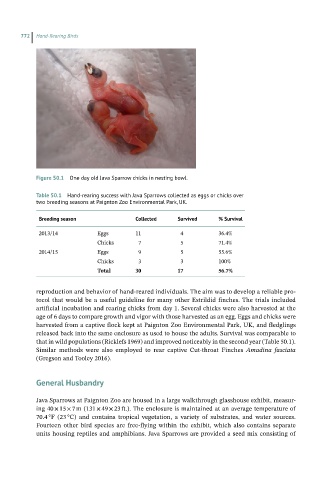Page 769 - Hand rearing birds second
P. 769
772 Hand-Rearing Birds
Figure 50.1 One day old Java Sparrow chicks in nesting bowl.
Table50.1 Hand-rearing success with Java Sparrows collected as eggs or chicks over
two breeding seasons at Paignton Zoo Environmental Park, UK.
Breedingseason Collected Survived %Survival
2013/14 Eggs 11 4 36.4%
Chicks 7 5 71.4%
2014/15 Eggs 9 5 55.6%
Chicks 3 3 100%
Total 30 17 56.7%
reproduction and behavior of hand‐reared individuals. The aim was to develop a reliable pro -
tocol that would be a useful guideline for many other Estrildid finches. The trials included
artificial incubation and rearing chicks from day 1. Several chicks were also harvested at the
age of 6 days to compare growth and vigor with those harvested as an egg. Eggs and chicks were
harvested from a captive flock kept at Paignton Zoo Environmental Park, UK, and fledglings
released back into the same enclosure as used to house the adults. Survival was comparable to
that in wild populations (Ricklefs 1969) and improved noticeably in the second year (Table 50.1).
Similar methods were also employed to rear captive Cut‐throat Finches Amadina fasciata
(Gregson and Tooley 2016).
GeneralHusbandry
Java Sparrows at Paignton Zoo are housed in a large walkthrough glasshouse exhibit, measur -
ing 40 × 15 × 7 m (131 × 49 × 23 ft.). The enclosure is maintained at an average temperature of
70.4 °F (23 °C) and contains tropical vegetation, a variety of substrates, and water sources.
Fourteen other bird species are free‐flying within the exhibit, which also contains separate
units housing reptiles and amphibians. Java Sparrows are provided a seed mix consisting of

